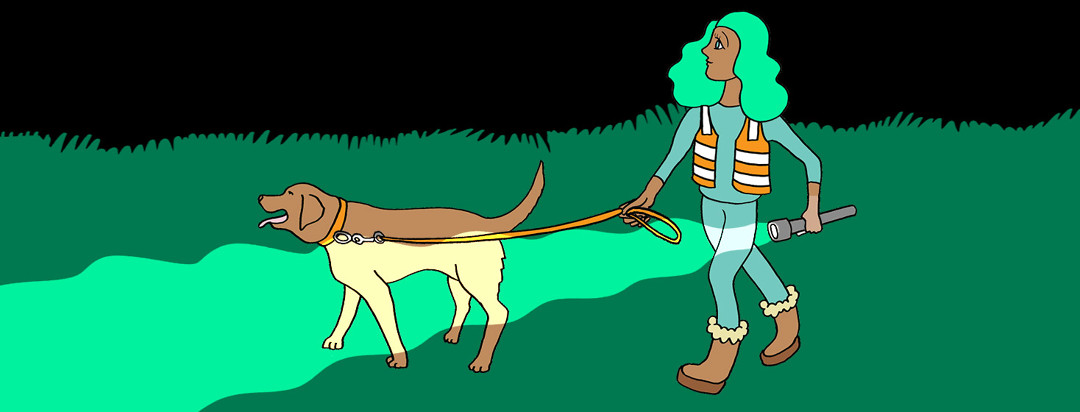VIP Walking Strategies for Safety
Daylight saving time is gone. Walking my two girls, two-year-old chocolate labs, is going to have to be accomplished after dark. Yippee. Time for some tips on defensive walking.
Reflective gear
I bought a new reflective vest. Very fashionable. It is yellow and has bright, orange stripes...o’kay, so it is not fashionable but it is more fashionable than a body bag, so I am wearing it. When you have trouble seeing the cars, you need to do something to assure the cars see you. That can be using a white cane or dressing in reflective gear or both.
Verywell’s "Night Walking Strategies for Safety and Fun" agreed with me that reflective gear should be the number one thing to do to keep safe on night walks.
Carry a light
For number 2 they suggest you carry a light. If you are walking in a poorly lit area or don’t know the terrain well, this is certainly an option. I, however, have found too bright a light can mess with my dark adaptation.
Blinded by the light
If I am looking at the area lit by the light and look away, Sasquatch could be standing there and I would not see him. For the same reason - messed up dark adaptation, not Sasquatch - I try never to look at oncoming headlights. Once my vision is “bleached out” by a bright light, I REALLY become blind for five or ten minutes.
Walking facing traffic
Poor dark adaptation and walking facing traffic don’t exactly work well together but both Verywell and I recommend walking facing traffic, especially at night. They say it is so you can see traffic. Maybe so, but I say it is so traffic can see YOU. In either case, I try to shield my eyes from the bright headlights. Dark adaption problems again.
Be aware
The article talks about being aware of your surroundings and not to do any distracted walking. It urges caution because of stranger danger. I don’t worry about meeting anyone dangerous on my dog walks. The girls go crazy and want to love to death anyone we meet. Getting through them to me would be a tall order. The reason I would advocate for being aware and not being distracted is sound awareness.
Sound awareness
What do I mean by sound awareness? I listen constantly when we are walking. I hear cars coming at me from the front and from the rear. I know the “stomp/snort” of a startled deer. Knowing those deer sounds gives me a split second to really clench the girls' leash and anchor my feet rather than face plant and get road rash as the dogs try to chase said deer. (The pups are, shall we say, impulsive. And enthusiastic. Definitely enthusiastic.) Being aware of car noises gives me plenty of time to step off the road and get both myself and my darlings to safety. With a little bit of practice, it is not hard to figure out where sounds are coming from and how close they might be.
Shorelining
Another technique I learned from the orientation and mobility person they sent me is “shorelining.” Shorelining simply involves figuring out where the road and, in my case, woods and fields meet and hugging that line. If I get my outside foot right up next to the weeds, I’m good. Better than standing in the middle of the road and not knowing you are there!
With some basic precautions, it is possible to go outside after dark. Even we visually impaired folks can enjoy an evening stroll. Just remember, walk defensively and be visible. Let’s make reflective vests high fashion!
Community Poll
Which type of macular degeneration are you seeking support for?

Join the conversation